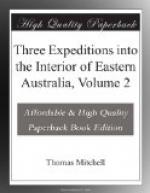(Footnote. This proves to be a new genus of Caprifoliaceae, paragraph mark Sambuceae. Tripetelus australasicus, Lindley manuscripts (tripetelos having 3 leaves; the calyx has 3 sepals, the corolla 3 petals, the stamens are 3, and the carpels are also 3). Calyx superus tridentatus. Corolla rotata, tripartita, lutea, laciniis concavis conniventibus. Antherae tres, fauce sessiles. Ovarium 3-loculare; ovulis solitariis pendulis; stigmata 3, sessilia. Fructus subexsuccus, 3-queter, 3-pyrenus, putamine chartaceo. Caulis herbaceus. Folia opposita, glabra, pinnata, 2-juga cum impari, laciniis lanceolatis acuminatis serratis; glandulis 2 verruciformibus loco stipularum. Flores laxe paniculati.)
Acacia pendula.
March 26.
This day at five miles further we ascended some undulating ground on which the acacias of the interior grew. We found the same ridged and wavy surface with the Acacia pendula and the pigeons which usually abound about such parts of the country. Here we found also a singular species of Jasmine, forming an upright bush not unlike a Vitex, with short axillary panicles of white flowers. It proved to be J. lineare, R. Br. We soon after came upon the borders of the great plain of Gullerong, which extends about eight miles from east to west, and three northward from a branch of the river, then quite dry. These I believe were the Solway-flats of Mr. Oxley. We turned from them late in the afternoon, at the suggestion of a native wearing a brass-plate like a bottle label, and on which was engraven Billy Hawthorne. We succeeded in reaching a bend of the river containing water only after travelling 18 1/4 miles; and in latitude 33 degrees 23 minutes 21 seconds South.
March 27.
This day being Sunday I halted; especially as the cattle had made an unusually long journey the day before. I wished to take sights for the purpose of ascertaining the rate of my chronometer, and to lay down my surveys. I found that Mr. Oxley’s points on this river were much too far to the westward; a circumstance to be expected as his survey could not, at that early age of the colony, be connected with Parramatta by actual measurement; as mine was. Our latitudes however agreed very exactly.
Ascend mount Amyot.
March 28.
Continued our journey and, at only a mile and a half from our camp, I was surprised to find myself at the foot of Mount Amyot, better known to stockmen by its native name of Camerberdang. I gave the party a bearing or distant object to advance upon; and I lost no time in ascending the hill, followed by Woods with my theodolite. From its crest, low as it was, I still recognised the Canobolas and ascertained from my drawings formerly made there that even on this hill (Mount Amyot) I had taken an angle from their summit last season. It was valuable now, enabling me to determine the true place of the hill from which I was to extend my angles further westward. I easily recognised Marga and Nangar, and a very useful and remarkable point of my former survey to the northward of those hills, also several still more conspicuous ones in the country beyond the Lachlan.




